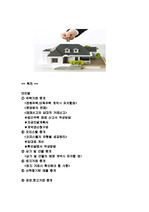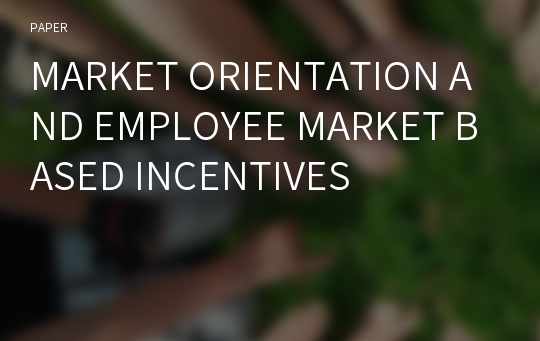MARKET ORIENTATION AND EMPLOYEE MARKET BASED INCENTIVES
* 본 문서는 배포용으로 복사 및 편집이 불가합니다.
서지정보
ㆍ발행기관 : 글로벌지식마케팅경영학회(GFMC)
ㆍ수록지정보 : Global Marketing Conference
ㆍ저자명 : Ville Kylmänen, Iiro Vaniala, Juho-Petteri Huhtala
ㆍ저자명 : Ville Kylmänen, Iiro Vaniala, Juho-Petteri Huhtala
영어 초록
Introduction A market orientation is a fundamental concept of strategic marketing that reflects a thorough understanding of both customer needs and competition (Narver & Slater, 1990; Kohli & Jaworski, 1990; Salavou et al., 2004). Market orientation as organizational culture increases firms’ interest in providing greater value for its customers, and, consequently enhances business performance (Narver & Slater, 1990). Thus, it is important to understand processes related to development and management of market-oriented culture (Zhou, Gao, Yang, & Zhou, 2005). As practitioners are encountering many difficulties in implementing market orientation in their organizations (Day, 1994; Mason & Harris, 2005), more detailed studies have been called to investigate managerial processes of deploying and developing market-oriented culture (Harris, 2000). Recent studies have found that market orientation can be enhanced by top management emphasis and reward systems (Kirca, Jayachandran, & Bearden, 2005; Kumar, Jones, Venkatesan, & Leone, 2011). However, fewer studies have specifically looked into the remuneration of the management in this setting (Ruekert, 1992), and particularly how the different parts of employee compensation, such as incentive schemes, are structured. Although our understanding of how compensation structure effects on development of market-oriented culture is limited, compensation structures have been studied extensively in finance literature (see Murphy 2012 for an extensive review). The structure of employee incentive schemes may be used to shift personnel’s myopia and risk-taking behavior (Murphy, 1999). Thus, these schemes provide a classic solution to the agency problem between shareholders and management (Jensen & Murphy, 1990) and have been predominantly postulated to be beneficial for the shareholder (Murphy, 1999). The underlying rationale is that the managers perceive risk differently from the shareholders and because of this asymmetry the managers may be hesitant to undertake projects that would be optimal for the shareholder value (Core, Guay, & Larcker, 2003). In this study, our aim is investigate how the structure of the employee incentive schemes affects to the market orientation of the firm. Given that the benefits of market orientation take time to become fully realized, the importance of top management both emphasizing and supporting a market-oriented culture is paramount (Kumar, Jones, Venkatesan, and Leone, 2011). Since developing market orientation is by its nature a long-term and risky investment (Jaworski & Kohli, 1993), and is linked to superior firm performance, we postulate the development of market orientation as an activity that stock-based compensation is meant to promote. Literature review and hypotheses development Market orientation as organizational culture is “the set of beliefs that puts the customer's interest first, while not excluding those of all other stakeholders, such as owners, managers and employees, in order to develop a long term profitable enterprise” (Deshpande Farley, & Webster, 1993, p. 27). As positive relationship between market orientation and business performance has been empirically proven (Huhtala et al., 2013; Deshpande & Webster, 1989; Narver & Slater, 1990), recent studies have focused on investigating possible antecedents of market orientation, such as reward systems (Kirca et al., 2005; Kumar et al., 2011; Sarin & Mahajan, 2001, Wei, Frankwick, & Nguyen, 2012). Studies have found that proper reward systems, such as participation based rewards, may facilitate market orientation (Sarin & Mahajan, 2001; Wei et al., 2012). Development of our hypotheses is based on the understanding that, firstly, market orientation is only acquired through risky and time-consuming projects (Jaworski & Kohli, 1993), and, secondly, stock-based incentive schemes are specifically designed to mitigate risk aversion and myopic investment choice challenges (Murphy, 1999). The benefits of a market orientation take time to realize, and especially management support is needed to instill a market-oriented culture (Kumar et al., 2011). This type of management involvement is also reflected in Jaworski and Kohli's (1993) statement that risk-averse management leads to subordinates being less likely to focus activities that increase overall market orientation. The reward and compensation system is a critical factor as it can either encourage or impede managers’ actions (Hambrick & Snow, 1989), and, therefore, has an impact on market orientation (Wei et al., 2012). We argue that stock-based incentive schemes address the challenges of developing market orientation that has been found in extant literature (see Mason & Harris, 2005). The incentives should both motivate employees to focus more on long-term value creating activities as well as encourage them to overcome their risk aversion. As the market-based incentive systems aim to promote longer-term focus and reduce risk-aversion, which are major factors causing managers’ inertia to develop market orientation. In line with incentive and reward systems literature we propose that: H1(a)/(b): An increase in (a)option/(b)stock incentive schemes' total average value per employee involved increases a firm's market orientation (and its constituent factors) Organizations should provide more bonuses and long-term incentives to high level managers, since decision-makers in the upper echelons can have impact on the organization (Wang, Venezia, & Lou, 2013; Gerhart & Milkovich, 1990; Hambrick & Mason, 1984). We argue that top managers are the priority when designing stock-based compensation and the larger the proportion of employees benefiting from an incentive scheme within a firm is, the better the relevant decision-makers and experts have been incentivized. Thus, we propose: H2(a)/(b): An increase in the proportion of employees benefiting from an (a)option/(b)stock incentive scheme increases a firm's market orientation (and its constituent factors) Data and methods The incentive scheme data was obtained from Alexander Incentives, a remuneration scheme consultancy that administers a broad database of publicly disclosed information on the remuneration and incentives of public and private companies in Finland. We use data from 2008 to 2012 comprising 67 firms. Over this period the average year specific value of an option based incentive scheme was 4.7 million € and corresponding value of a stock based incentive scheme was 7.6 million €. On an average year, an option based scheme comprised 595 grantees and a stock based scheme comprised 317 grantees. Measurement of market orientation was conducted through survey using the questionnaire items developed by Narver and Slater (1990). The survey was conducted in the spring of 2008, 2010 and 2012. The survey was sent to all companies in Finland with more than 5 employees in the previous year resulting 1157, 1134, and 952 completed answers, respectively. The respective firm-level response rates were 16%, 10% and 9%. However, in this study, we are investigating only the companies that were publicly listed at the time of conducting the survey and who have disclosed personnel incentives. Such companies answering the survey totaled 55 firms in year 2008, 39 in 2010, and 28 in 2012. The final sample consisted of firms that responded to the survey in one or more years and from which we were able to obtain incentive scheme data. The sample comprises 122 firm-years collected from 65 unique firms (n = 122). The items measuring market orientation were evaluated with confirmatory factor analysis (CFA) using SPSS AMOS version 21.0. The latent variables measuring the dimensions of market orientation (customer orientation, competitor orientation, and interfunctional coordination) were included in a single second-order CFA model. Following suggested guidance for the model fit index thresholds (Bagozzi & Yi, 2012; Bentler, 1990), the second-order CFA model shows a good fit (χ2 = 58.08, df = 24, χ2/df = 2.42, RMSEA = .10, SRMR = .047, NNFI = .94, and CFI = .96). All items loaded significantly on their respective second-order (standardized loadings ranged between .90 and .95) and first-order latent constructs (standardized loadings ranged between .68 and .96), indicating convergent validities. All model maximum likelihood estimates were found to have statistically significant critical ratio values. We conclude that the tests proved the factorial validity of the second-order CFA model. Additional financial data was used to formulate control variables and was obtained from Worldscope and Datastream. We are using annual and quarterly financial statements data to control the size of the companies and the volatility of the environment. Stock market data were used to control the riskiness of the firms. We are controlling for the size of the firm with the logarithm of the total assets. To control for the environment, we are using the volatility of the quarterly revenues within a year. We also use the monthly volatility of the stock market performance to control for the investors’ perceptions of riskiness. Detailed descriptive statistics of the sample are available upon request. Results The impact of the employee stock-based incentives on the market orientation of the firm was investigated using multiple regression analysis. We used the market orientation as the dependent variable. As the independent we used the value of the incentive scheme (option and stock based) per grantee and the percentage of total employees who were grantees. Total assets, quarterly revenue volatility, and monthly stock returns volatility were control variables. The variable for market orientation significantly correlated with option scheme value (p < .10), presenting a low correlation of -.17. Quarterly sales volatility significantly correlated with monthly stock return volatility at -.21 (p < .05). Other correlations were found statistically insignificant and ranged between -.14 and .23. Table 1 reports the regression results predicting market orientation. Models 2 and 4 test Hypotheses 1(a) and 2(a). Models 3 and 4 test Hypotheses 1(b) and 2(b). All Models 1 through 4 were found statistically significant based on the F-statistic (p < .01). Hypothesis 1(a) proposed increase in option incentive scheme’s total average value per employee predicts increase in a firm's market orientation. As indicated in Model 2 and 4, there is no strong support for the hypothesis. Although the coefficient for option scheme value is significant (p < .10), the coefficient is negative instead of being positive as was hypothesized. Hypothesis 2(a) postulated the option scheme coverage to have a positive impact on the market orientation of the firm. The coefficient in both Models 2 and 4 was positive, however not significant. Thus, the Hypothesis 2(a) is clearly rejected.참고 자료
없음태그
"Global Marketing Conference"의 다른 논문
 THE ROLES OF GREEN PACKAGING IN UGLY FOOD PURCHASE INTE..22페이지
THE ROLES OF GREEN PACKAGING IN UGLY FOOD PURCHASE INTE..22페이지 THE IMPACT OF INDUCED AWE ON ETHICAL TOURIST BEHAVIORS5페이지
THE IMPACT OF INDUCED AWE ON ETHICAL TOURIST BEHAVIORS5페이지 A BIBLIOMETRIC ANALYSIS OF SPIRITUAL TOURISM RESEARCH15페이지
A BIBLIOMETRIC ANALYSIS OF SPIRITUAL TOURISM RESEARCH15페이지 SOCIAL NETWORK ANALYSIS AND RESPONSE TIME TESTING: CONS..11페이지
SOCIAL NETWORK ANALYSIS AND RESPONSE TIME TESTING: CONS..11페이지 THE EFFECTS OF PARA-SOCIAL INTERACTION ON ONLINE CELEBR..3페이지
THE EFFECTS OF PARA-SOCIAL INTERACTION ON ONLINE CELEBR..3페이지 THE INFLUENCE OF OPINION LEADERS ON DAILY DEALS USER’S ..3페이지
THE INFLUENCE OF OPINION LEADERS ON DAILY DEALS USER’S ..3페이지 HOW IMMERSIVE RETAILING AFFECTS CONSUMERS’ URGE TO BUY:..6페이지
HOW IMMERSIVE RETAILING AFFECTS CONSUMERS’ URGE TO BUY:..6페이지 KEY TO SUPERSTARDOM IN A GLOBALISED MARKET: THE ROLE OF..6페이지
KEY TO SUPERSTARDOM IN A GLOBALISED MARKET: THE ROLE OF..6페이지 A POST-PANDEMIC LOOK AT TOURISTS’ PERCEIVED COOLNESS OF..4페이지
A POST-PANDEMIC LOOK AT TOURISTS’ PERCEIVED COOLNESS OF..4페이지 EXTRACTING OFFLINE RETAIL SHOPPING PATTERNS: OLLABORATI..5페이지
EXTRACTING OFFLINE RETAIL SHOPPING PATTERNS: OLLABORATI..5페이지


























